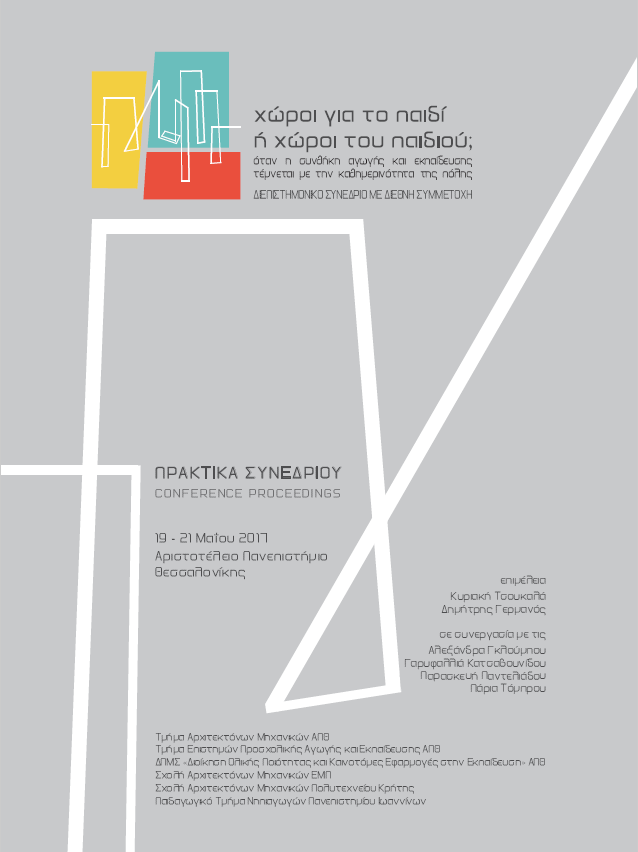Η συμμετοχή των παιδιών στον ανασχεδιασμό της σχολικής αυλής με τη χρήση σχεδιαστικού εργαλείου νέων τεχνολογιών

Περίληψη
Η συμμετοχική διαδικασία των παιδιών στον (ανα)σχεδιασμό της αυλής του σχολείου τους θεωρείται μία από τις ισχυρότερες και πιο αποτελεσματικές διαδικασίες για τη βελτίωση του χώρου αυτού και εγγυάται τη βιωσιμότητα της προσπάθειας, καθώς (ανα)σχεδιασμός, βελτίωση και διαχείριση στηρίζονται στα παιδιά. Έχουν αναπτυχθεί μεθοδολογικά εργαλεία για τον σκοπό αυτόν και υπάρχει πλήθος ερευνητικών δεδομένων. Δεν υπάρχουν όμως ερευνητικά δεδομένα επικεντρωμένα στη χρήση των ΤΠΕ ως εργαλείων ενεργοποίησης της παιδικής συμμετοχής στον σχεδιασμό του υπαίθριου σχολικού χώρου. Στην εργασία παρουσιάζονται δεδομένα από τη χρήση και αξιολόγηση ενός προσαρμοσμένου λογισμικού σχεδίασης (Tux Paint) από παιδιά δημοτικού σχολείου με σκοπό την πρόταση ανασχεδιασμού της αυλής του σχολείου τους.
Το εργαλείο αυτό επέτρεψε στα παιδιά ελευθερία έκφρασης στις σχεδιαστικές προτάσεις, χωρίς να περιορίζονται από σχεδιαστικά αρχέτυπα, όπως συμβαίνει με τα εξειδικευμένα σχεδιαστικά λογισμικά. Παρείχε δυνατότητες για συνεργασία, δράση και ενίσχυση της δημιουργικότητας και της φαντασίας τους. Προέκυψε μία ογκώδης βάση δεδομένων, αναφορικά με τις επιθυμίες και τις τοπιακές προτιμήσεις των παιδιών, που συγκλίνουν στη δημιουργία μίας πράσινης σχολικής αυλής με προτάσεις αισθητικού, λειτουργικού και οικολογικού χαρακτήρα. Η αξιολόγηση του διαδραστικού λογισμικού από τα παιδιά ήταν πολύ θετική ως προς την ευκολία χρήσης του, τις δυνατότητες για συνεργασία, αλλά και το τελικό σχεδιαστικό προϊόν.Λεπτομέρειες άρθρου
- Ενότητα
- ΘΕΜΑΤΙΚΗ IV Εισαγωγή καινοτομιών για αναβάθμιση του εκπαιδευτικού περιβάλλοντος
Οι συγγραφείς των άρθρων που δημοσιεύονται διατηρούν τα δικαιώματα πνευματικής ιδιοκτησίας επί των άρθρων τους, δίνοντας το δικαίωμα της πρώτης δημοσίευσης.
Άρθρα που δημοσιεύονται διατίθενται με άδεια Creative Commons 4.0 και σύμφωνα με την άδεια μπορούν να χρησιμοποιούνται ελεύθερα, με αναφορά στο/στη συγγραφέα και στην πρώτη δημοσίευση για μη κερδοσκοπικούς σκοπούς.
Οι συγγραφείς μπορούν να καταθέσουν το άρθρο σε ιδρυματικό ή άλλο αποθετήριο ή/και να το δημοσιεύσουν σε άλλη έκδοση, με υποχρεωτική την αναφορά πρώτης δημοσίευσης στα πρακτικά.
Οι συγγραφείς ενθαρρύνονται να καταθέσουν σε αποθετήριο ή να δημοσιεύσουν την εργασία τους στο διαδίκτυο πριν ή κατά τη διαδικασία υποβολής και αξιολόγησής της.


